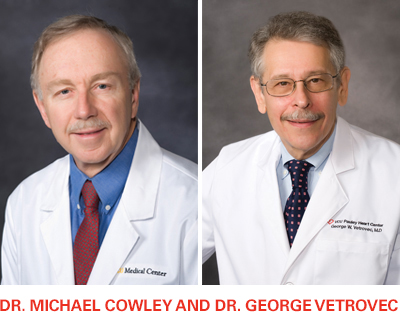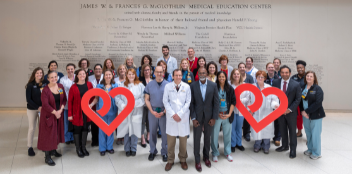Celebrating 40 Years of Angioplasty
In July 1979, interventional cardiologists Dr. Michael Cowley and Dr. George Vetrovec became the first doctors in Virginia to perform a balloon angioplasty on coronary arteries. The procedure took place in VCU Medical Center’s cardiac catheterization lab, which was located in the West Hospital at the time.

“It was new, it seemed very exciting, very few people were in it. It was an opportunity to be innovative and cutting edge and do something to make VCU special. And we were young and ambitious and decided to take it on,” said Vetrovec, with a laugh. “It paid off well.”
Dr. Andreas Gruentzig first pioneered the procedure in Zurich, Switzerland in September 1977. The intervention involves first directing a tube—known as a guiding catheter—to the coronary arteries. Dye is released through the catheter, and an angiogram is taken. Then, a second catheter with a balloon on its tip is directed through the guiding catheter to the area of blockage. The balloon is inflated, pushing the plaque against the walls of the artery, and allowing the blood to flow freely again.
“We thought it was very intriguing and had a lot of potential, so we contacted [Gruentzig],” said Cowley. “I had the opportunity to go over and spend several weeks working with him one-on-one in December 1978.”
In April 1979, Cowley returned to Zurich, this time with Vetrovec. They attended Gruentzig’s second large-scale training session, where about 200 were in attendance.
The pair also collaborated with the few physicians in the U.S. that were undertaking angioplasties, such as Dr. Kenneth Kent at the National Institutes of Health Clinical Center. Cowley provided the teams with much-needed catheters, which he had brought back from Switzerland.
Then, it was their turn. “I think we were one of the first ten centers in the U.S. to do the procedure,” said Cowley. “We actually held off on doing it for a while because we were in the process of having a new cath lab installed that had better resolution. The new lab opened in June 1979, and we did our first angioplasty in July 1979.”
“I went with Dr. Richardson and we talked to Dr. Lower,” said Vetrovec. Lower listened to them as they made their case, then responded. “He said, ‘First of all, I’m not sure this is going to work.’ Then he said, ‘But in the interest of science, I will stand by for you,’” recalled Vetrovec. “I have the greatest respect for the open-mindedness and the scientific spirit that Dr. Lower exhibited.”
Cowley and Vetrovec’s first patient arrived from out of town with a referral for an evaluation of chest pain. The patient had a significant blockage in their anterior descending—one of the major arteries of the heart.
“We presented it all to the patient, and they were agreeable to doing this—being the first one at VCU Medical Center. We had an outside physician who had experience doing the procedures, and he was there for advice and proctoring,” recalled Vetrovec. “It went very well. We were very excited that it did, given the statistics at the time. Generally, centers had about a 65% success rate. The patient was happy too, because bypass surgery was avoided.”
Dr. David Richardson, chair of cardiology at that time, and Dr. Richard Lower, chief of cardiothoracic surgery at that time, were essential to the launch of the program. Their support of the cardiac surgical team was essential, said Vetrovec, since those physicians had to be on-hand in case emergency surgery was required.
Back to Autumn-2019

